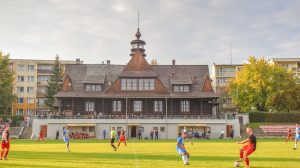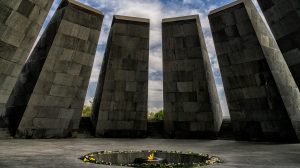Christo Vladimirov Javacheff dared to dream on an epic scale. His art stepping far beyond the boundaries of the canvas and into the world, having created masterpieces on Australian costs, Californian hillsides and even the Reichstag. Christo, as he was known, sadly died last Sunday at the age of 84, but his genius and impact on the art world will long outlive him.
Christo was born in 1935 in Gabrovo, a small Bulgarian mountain town and experienced a rather bohemian upbringing. His mother was a political activist and circles of intellectuals and artists along with their radical ideas often circulated in the living room. With a childhood influenced by questioning and subverting contemporary culture, Christo’s creativity was encouraged from a young age.
Then World War II broke out, and political upheaval greatly shaped his early years. In 1952 he began attending the art academy in Sofia, yet the expectation to create art of socialist values eventually became too stifling. Christo knew that his artistic expression could not be moulded. As he famously said, “the work of art is a scream of freedom”.
He moved to Prague and became drawn into a city filled with artists and innovators, benefitting from a slightly looser form of government. But even Czechoslovakia was too much for such a free spirit, and in 1956, Christo saw his chance to escape a surmounting pattern of suppression.
He fled by bribing a railway worker and hiding on a train bound for Austria. Against all the odds, he found himself in Vienna, stateless and only able to speak Russian and Bulgarian. At the time Europe was a sea of refugees, and made his way to Paris, making ends meet by painting people’s portraits on the street – not exactly the levels of artistic creation he saw for himself.
Yet by pure chance, this job saw his life change forever. A woman saw his portraits and invited him to paint her. Her daughter was Jeanne-Claude Denat de Guillebon. The two were soul-mates, both creatively and romantically. They would become inseparable.
The pair heavily influenced each other, and Jeanne-Claude’s influence on Christo cannot be underestimated. One story goes that she once walked into his attic and saw vast numbers of wrapped objects, apparently influenced by Man Ray’s 1920 work of a wrapped sewing machine. Despite thinking “my god this guy is crazy”, she also saw talent and opportunity.
The pair, known as Christo and Jeanne-Claude, went on to change the art world together in an unrivalled artistic collaboration that lasted over 50 years. They dared to dream on an epic scale, and this attic of wrapped household items was extrapolated to large scale masterpieces as Jeanne-Claude encouraged Christo move away from smaller objects.
One of their first works was seen as a reaction to the Berlin Wall, in 1962 when the pair blocked off Rue Visconti in Paris with oil drums. Despite pleading with police to let the installation remain, it was taken down in a matter of hours. This temporary grandeur soon became second nature to their work, which took years to plan but was gone in a matter of days.
After moving to New York, the pair sold sketches to finance their creations. Every piece of work was self-funded, as grants were seen as limitations on artistic vision. Christo and Jeanne-Claude went on to create works on a gobsmacking scale. Millions of dollars, years of planning, even longer to gain the necessary legal permissions, tonnes of fabric and hours to witness the works in their entirety.
Soon after their 1962 debut, the pair quickly upped the scale, wrapping two kilometres of Australian coastline. Jeanne-Claude became skilled at gaining permissions, hiring lawyers and working the logistics, and the duo’s talents dovetailed seamlessly.
While the thought of wrapping a coastline may seem absurd, witnessing nature enclosed in a white fabric that became transient with the wind was capable of overturning a sense of place. While Christo famously claimed that his work was nothing more than aesthetics, a move which critics were not impressed by, these aesthetics challenged the idea of sculpture itself. Instead of a permanent and solid artwork it became temporary and disruptive, blurring the line between art and the outside world.
These ideas run through Christo and Jeanne-Claude’s work, as the world became their canvas, at least temporarily. In one of their most famous works, the pair wrapped 11 islands in Miami’s Biscayne Bay Area with more than 600,000 metres of bright pink polypropylene individually cut to each shoreline that needed 400 people to install. That it all had to be taken down a few weeks later was part of the beauty. The idea of a pink border encompassing a series of islands can twist the imagination, only to be gone a few weeks later, give it a mythical and almost dream like quality. Did that really happen? Was the sea really pink or did I just imagine it?
Other works were on the same scale, if not larger. From a 40 kilometre-long fabric fence in California, to thousands of huge umbrellas in Japan and California, to an enormous mastaba in London. They dared to dream, and realise those dreams.
Nature was not their only canvas however, as the duo famously turned to buildings. In 1984, after nine years of lobbying the Parisian mayor Jacques Chirac, they wrapped the Post Neuf in a glimmering sandstone fabric, as if imitating sunset. This obscured the building’s intricate Gothic architecture into something that moved and shifted with the wind, once again subverting a sense of place turning something so concrete into a work of abstraction.
This culminated in the wrapping of the Reichstag in 1995, which the pair saw as a symbol of Cold War, East-West relations that had shaped so much of Christo’s early years. The building became hidden by fragile material that distorted its iconic structure, and people flocked to see it. As Christo said, “they knew they were seeing something that would never happen again.” They were seeing the impermanence of human achievement, against the permanence of the world surrounding it. “They all go away when they’re finished,” Christo once said of his works. “Only the preparatory drawings and collages are left, giving my works an almost legendary character. I think it takes much greater courage to create things to be gone than to create things that will remain.”
Jeanne-Claude died in 2009, yet the pair were so intertwined that Christo continued to work, creating for her a legacy. He pushed on with unfinished works, such as a golden path on Lake Iseo in Italy. At the time of Christo’s death, he had plans to wrap the Arc de Triomphe, where had been suspended until 2021 due to Covid-19.
Perhaps his biggest unrealised plan was the only work that was meant to be permanent. A colossal scale mastaba in the deserts of Abu Dhabi made out of oil barrels, set to be larger than the Egyptian pyramids, symbolising a stairway to heaven.
It is this dreamlike vision for which Christo and Jeanne-Claude should be remembered.
—
Unlike many news and information platforms, Emerging Europe is free to read, and always will be. There is no paywall here. We are independent, not affiliated with nor representing any political party or business organisation. We want the very best for emerging Europe, nothing more, nothing less. Your support will help us continue to spread the word about this amazing region.
You can contribute here. Thank you.






Add Comment